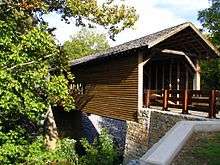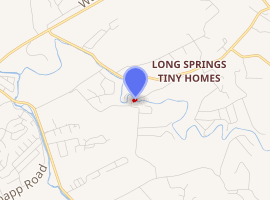Harrisburg Covered Bridge
The Harrisburg Covered Bridge (also called Pigeon River Covered Bridge, East Fork Bridge or McNutts Bridge) is a historic covered bridge in Sevier County, Tennessee, in the United States. It is located east of Sevierville off U.S. Highway 441. The bridge is a king post truss design and crosses the East Fork of Little Pigeon River.
Harrisburg Covered Bridge | |
|---|---|
 Harrisburg Covered Bridge (2006) | |
| Coordinates | 35.860943°N 83.482549°W |
| Crosses | East Fork Little Pigeon River |
| Locale | East of Sevierville (Tennessee) |
| Characteristics | |
| Design | King post truss covered bridge |
| Width | 88 feet (26.9 m) |
| Longest span | 64 feet (19.5 m) |
| History | |
| Construction end | 1875 |
| Statistics | |
| Daily traffic | 20 |
Harrisburg Covered Bridge | |
| NRHP reference No. | 75001777[1] |
| Added to NRHP | June 10, 1975 |

| |
History
Before the Harrisburg Bridge was built in 1875, the McNutts Bridge, which was washed away during a flood, existed in the same place. In March of that year, the Sevier County Court ordered a panel to be used to carry out and organize the construction of a new bridge. Panel members were J.H. Frame, A.E. Murphy, and D.W. Howard. As usual at the time, the local population contributed to the financing, or provided them with construction material, or worked as an assistant in building the project. The voluntary cash donations totalled $50, with the county's $25 contribution.
Elbert Stephenson early (1850 – 1917) was appointed as head of the new construction project. The early family settled in the area in the 1870s. Many of the family members were trained craftsmen, including carpenters, mill builders, locksmiths and engineers. Elbert participated in 1877, next to the bridge project, with 50 percent of the capital contribution of the Newport Mill by Alexander Umbarger. He was related to ___ wife Clementine (1843 – 1922).
In the late years of the 19th century, the population grew around Harrisburg, and life in the area flourished due to the many local mills and blacksmith workshops. After 1915 a new bypass was built around Harrisburg, the community slowly disappeared as many people moved away.
In 1952 the bridge was stabilized with the help of a concrete bridge pillar attached to the building framework.
In the 1970s, the overall state of the bridge had deteriorated so much that it was thought to demolish it, until the organization Daughters of the American Revolution raised the necessary financial resources to rehabilitate the bridge by donating revenue. It was also the organization that made the request to include the bridge in the National Register of Historic Places, which succeeded on June 10, 1975 (NRHP-ID 75001777).
In 1983 the bridge was re-established, but it was noted on the bridge that the crossing for vehicles must not exceed the permissible total weight of three tons.
In 2004 various repairs were carried out on the bridge. After this further renovation, the permissible total weight was increased to 15 tons. As of 2010, an average of 20 vehicles per day crossed the bridge.
Construction details
The span of the bridge is 64 feet (19.5 m), the total length 88 feet (26.9 m), the inner width 10 feet (3.2 m). The building material of the walls consists partly of tinplate.[2][3][4]
See also
References
- "National Register Information System". National Register of Historic Places. National Park Service. July 9, 2010.
- NRIS
- Covered Bridges in Tennessee - Tennessee Department of Transportation
- "History of Sevier County Tennessee". Archived from the original on 2011-09-07. Retrieved 2017-09-11.